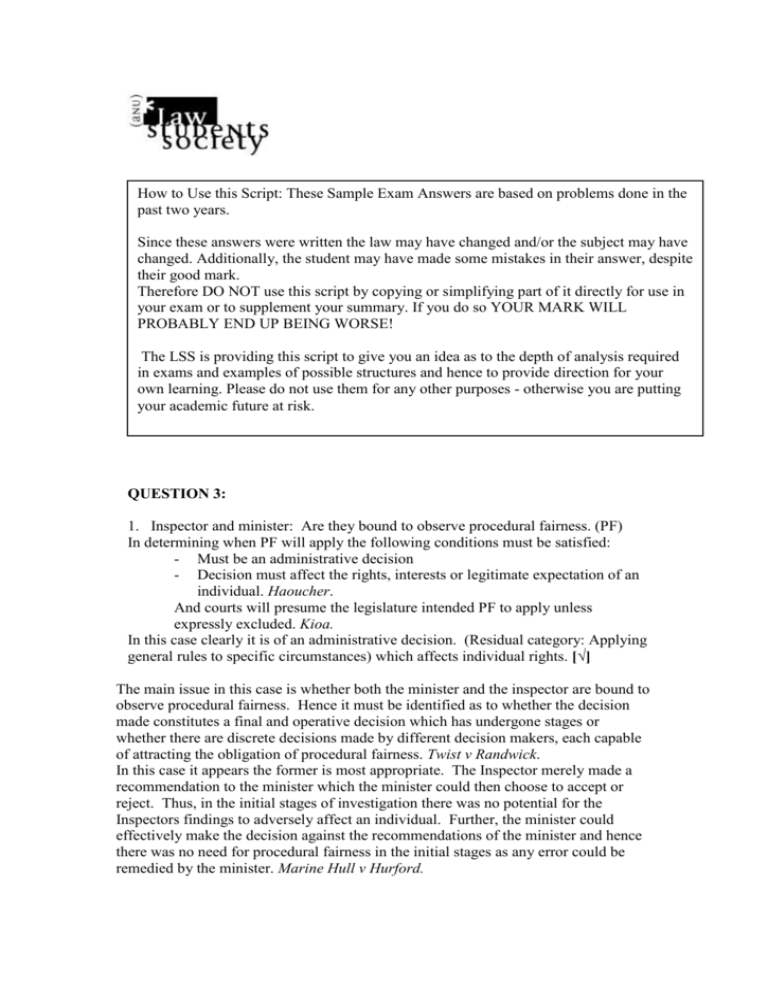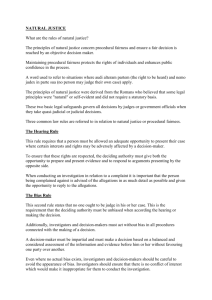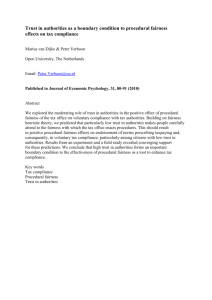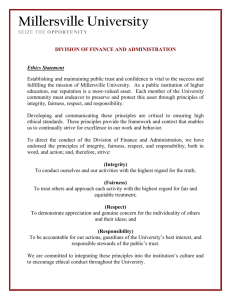QUESTION 3: - ANU Law Students` Society
advertisement

How to Use this Script: These Sample Exam Answers are based on problems done in the past two years. Since these answers were written the law may have changed and/or the subject may have changed. Additionally, the student may have made some mistakes in their answer, despite their good mark. Therefore DO NOT use this script by copying or simplifying part of it directly for use in your exam or to supplement your summary. If you do so YOUR MARK WILL PROBABLY END UP BEING WORSE! The LSS is providing this script to give you an idea as to the depth of analysis required in exams and examples of possible structures and hence to provide direction for your own learning. Please do not use them for any other purposes - otherwise you are putting your academic future at risk. QUESTION 3: 1. Inspector and minister: Are they bound to observe procedural fairness. (PF) In determining when PF will apply the following conditions must be satisfied: - Must be an administrative decision - Decision must affect the rights, interests or legitimate expectation of an individual. Haoucher. And courts will presume the legislature intended PF to apply unless expressly excluded. Kioa. In this case clearly it is of an administrative decision. (Residual category: Applying general rules to specific circumstances) which affects individual rights. [√] The main issue in this case is whether both the minister and the inspector are bound to observe procedural fairness. Hence it must be identified as to whether the decision made constitutes a final and operative decision which has undergone stages or whether there are discrete decisions made by different decision makers, each capable of attracting the obligation of procedural fairness. Twist v Randwick. In this case it appears the former is most appropriate. The Inspector merely made a recommendation to the minister which the minister could then choose to accept or reject. Thus, in the initial stages of investigation there was no potential for the Inspectors findings to adversely affect an individual. Further, the minister could effectively make the decision against the recommendations of the minister and hence there was no need for procedural fairness in the initial stages as any error could be remedied by the minister. Marine Hull v Hurford. Therefore assuming two decisions are part of the one process in which there is not procedural fairness owed by inspector as any breach can be remedies in the second stage as the minister is able to make an independent analysis and does not merely apply inspectors findings. [√√] 2. There is a common law presumption reflected in the ADJR Act under s 5(1)(a). As there is nothing in the Act to expressly limit the obligation to observe procedural fairness, if it can be established that someone’s rights, interests or legitimate expectation will be affected by the decision, then procedural fairness will be established. Jia, Kioa. It must be a procedural, not substantive obligation. To determine if procedural fairness applies a multi-factual approach must be adopted, taking into account the individual circumstances of each case. FAI. [√] Factors: a. Rights and Interest Affected: In this case the ministers decision clearly affected the interests of an individual, namely Liam which differs from the impact on wider members of the public. Kioa. Liam’s business has been directly affected by the decision, thus suggesting this element would be established. (?) b. Legitimate Expectation: Liam may argue he held an expectation of a procedural right, advantage or opportunity. This is a question of fact. In this case, based on the considerations in the Act. s 2(a),(b) Ian may argue that he expected the potential of closure of existing pools such as his would be an influencing factor, and if this was to change, he would be informed. FAI. Ian must establish that this legitimate expectation was reasonable, well founded and more than hope. Haoucher Also reliance and detriment. Lamb. This appears to be established on the facts. [√] c. Nature of Power being Exercised: Decisions legislative in nature which are likely to apply more generally to public are less likely to attract procedural fairness obligations. FAI Insurance. Thus if it can be established that this decision was a polycentric decision, Liam’s argument of procedural fairness would be significantly undermined. Liam could argue that although there were policy considerations and the consideration of the public interest under s2(a), the decision was still made a matters of individual merit, s2(b) and therefore procedural fairness is still required. Ridge v Baldwin, FAI The impact and degree of adversity on the person is also an influencing factor. FAI. Assuming that there exists two parts to the same decision, there is no express right of appeal and based on the above analysis it appears that despite the policy considerations involved, there is sufficient impact on the individual interests. [√√] Assuming that there exists two parts to the same decision, there is no express right of appeal. And, based on the above analysis it appears that despite the policy considerations involved, there is sufficient impact on individual interests to establish an obligation of Procedural fairness in relation to the Minister’s final decision. The scope and content of procedural fairness must now be determined: This addresses the question as to the extent of participation of the individual should have or the affect of the alleged bias. Content of the obligation includes: 1. Hearing Rule 2. No Bias Rule 3. Logical Evidence Rule 4. Duty to Inquire In this case, the Hearing Rule and No Bias rule appear the most relevant [√√] Hearing Rule: The direct and immediate effect (?) on Liam’s rights, interests or legitimate expectations established the requisite elements for the hearing rule. Thus the three required must have been afforded to Liam: a. Prior notice of decision b. Disclosure of information on which decision is to be based c. Opportunity to comment and present own case [√] In this case, Liam was not consulted or even notified regarding the ministers decision despite requesting access to the information on which the decision was based, namely the 1995 survey. Further, Liam was denied the opportunity to comment on that information or to present his own case- that his pool was not overly crowded in summer. Thus the failure to disclose facts that were to adversely affect Liam and the denial of a fair opportunity to Liam to present his individual case constitutes a violation of Procedural Fairness obligations. The minister has therefore failed to observe the requisite procedural fairness obligations resulting in an invalid decision. [√√] Rule Against Bias: There exists two categories of bias- Actual and Apprehended bias. In this case, apprehended bias appears to be the ground easiest to establish as actual bias requires the proof of a subjective state of mind. Jia. Under apparent/ostensible bias it must be proven that the relevant circumstances gave rise in the mind of a fair minded observed to a reasonable apprehension that the decision maker may not bring an impartial mind to the case. Liversey In this instance, based on the dealings between the Minister and Kingston developer there appears a potential conflict of interests that may potentially result in apprehension of bias. While there only needs the possibility rather than probability of apprehension (Ebner) based on degree of effect and connection this may be difficult to prove. A decision maker is permitted to have prior knowledge and opinion or relations in the regards to the decision, however they must not close their mind to further persuasion. R v Cth Conciliation and Arbitration. Thus, there is a clear distinction between an open mind and an empty mind. Jia Therefore this ground would be more difficult to establish based on the facts. [√√] Exceptions: The bias and hearing rule should not be involved in circumstances of: - Necessity. Laws v ABT - Waiver. Vakuta In this case the obligation of Procedural Fairness would not frustrate the purpose or operation of the act and Liam has not waived his right to object. Thus the obligation of procedural fairness in relation to the Minster’s final decision would be established. The content and scope of such an obligation would most likely be an obligation to provide a fair hearing. [√] 3. Standing: To bring this action, Liam must establish sufficient suitability to bring such an action for review. Based on a two stage test, Liam must establish firstly that he has a special interest in the action that goes beyond a mere intellectual or emotional concern, and is distinct from the interests of the public at large. Bateman’ s Bay This is reflected under s5 of the ADJR as “person aggrieved” Liam would be able to establish standing as his interest in the decision due to being an operator of a pool within the Kingston would be sufficiently close to the subject matter. Onus v Alcoa. [√] 4. Liam has a number of avenues available to him: i. FC under s 39B (x) ii. HC under s75(v) iii. SC under ADJR Act In this case as s16 grants discretionary and flexible remedies to the court this would be the best option. Clearly jurisdiction and justifiability would be established as the decision is of a final and operative nature (Bond), made under an enactment, (The Development Act) and is of an administrative character, (residual character- applying general legislation to specific circumstances). [√] As this is an ACT Act, ADJR is still available as there is an equal equivalent- ADJR Act 1989 (ACT) [√]







